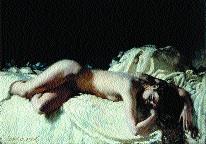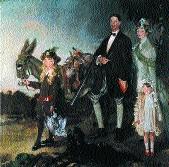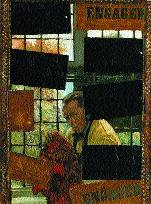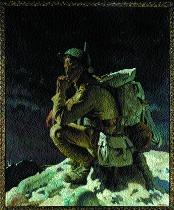Museum Eye
Published in Issue 4 (Jul/Aug 2005), Reviews, Volume 13
A woman (‘Nude study’), 1906. (Leeds Museums and Galleries)
Politics, sex and death—an exhibition of the paintings of Sir William Orpen
National Gallery of Ireland, Merrion Square, Dublin, until 28 August 2005
by Mark Coalter
Outside his native land the celebrated war artist and society painter, Sir William Orpen, is largely overlooked. As one of the most successful Irish painters of his day, and certainly the best remunerated, whose war images were exhibited in 1918 to popular acclaim, it is surprising that Orpen has fallen into relative obscurity, an imbalance that a new exhibition endeavours to redress.
Orpen, born in Stillorgan, Co. Dublin, in 1878, was of Anglo-Irish stock. Having artistically inclined parents who spotted and encouraged his talent from an early age, Orpen was enrolled at the Dublin Metropolitan School of Art at the age of twelve. In common with many in his artistic peer group in Ireland at the end of the nineteenth century—Lavery and Yeats spring to mind—he sought fame and fortune in London.
His early career focused on portraiture and nudes, both amply represented in this exhibition. As regards the latter, his style was innovative and, for contemporary audiences, occasionally scandalous. Gone were the classical and mythological influences capturing the idealised female form; these were replaced with something more personal. In A woman (‘Nude study’), painted in 1906, the image’s sensual aura, coupled with the crumpled sheets upon which the model lies, suggests a recent intimate encounter, which, for the age, was exceptionally risqué.

The Vere Foster family, 1907. (National Gallery of Ireland)
Portraiture takes many forms in this exhibition, with high society, politicians and the military represented. In later life Orpen painted celebrated figures such as Churchill, Haig and Foch, in the process forming influential relationships that aided his elevation to the establishment. At a more formative stage in his career Orpen’s progress was assisted by patronage from Evelyn St George, an American heiress, distantly connected to Orpen through marriage, whom he painted and with whom he had a long and passionate affair. During the Edwardian era commissions abounded, and his portraits of ladies, in particular of Lady Rocksavage, Vera Hone as The angler and of his wife, Grace Orpen, are striking. However, not all participants were happy with the finished product. The Vere Foster family, the subject of a group painting that has Hogarthian echoes, were most dissatisfied, Sir Vere complaining that ‘the donkey and all of us seem to share the same expression’.
A discussion of Orpen’s portraiture cannot afford to ignore his preferred subject—himself. Owing to insecurity about his height and facial features, his self-portraits involved donning a costume and/or emphasising a facial distortion, usually the exaggerated protrusion of his lower lip. This characteristic is particularly evident in his Self-portrait from 1912, where the artist peers into his mirror, the borders busy with notices, a cheque and possibly invitations, the sort of thing that would appear in the boudoir of any man-about-town, whilst The jockey and Ready to start: self-portrait testify to his fondness for the theatrical.
In 1904 Orpen returned to his alma mater in Dublin to teach. Owing to his Anglo-Irish background and professional base in London, Orpen had a complicated relationship with his homeland. He painted nationalist figures such as Tim Healy and Michael Davitt, the latter counselling ‘Don’t take any side, just live and learn to try and understand the beauties of this wonderful world’, advice which Orpen largely appears to have followed. Living part of the year in Howth, where he produced his most beautiful work, he witnessed the foiling of the Irish Volunteers’ gun-running and the subsequent shooting of some of their number by the British Army in 1914; naturally, he instinctively sympathised with his countrymen. However, he did not readily embrace Irish nationalism. His portrait Young Ireland: Grace Gifford, painted in 1907, is an ironic interpretation of one of his students and a future Republican activist, whilst simultaneously alluding to the growing self-confidence of Irish culture and identity. Sowing new seed and The holy well are serious attempts to develop these themes further. Because of the controversy that the former aroused, he provided a detailed explanation: Orpen himself

Self-portrait, 1912. (Cleveland Museum of Art)
represented the female character sowing seed—that is, trying to introduce new ideas into art—against the disapproval of the relevant authorities, which are represented by two austere figures, whilst the children (or ‘young Ireland’), both locked in good-natured struggle, are the grateful recipients. Interestingly, he later alluded to the ‘sowing lady’ as being analogous to Sinn Féin.
Using his establishment connections, Orpen secured a posting in 1917 to the Western Front as an official war artist, an experience that had a profound and shattering effect on his outlook and condition. This is the final strand of the exhibition, with the artist arguably at his most experimental. Owing to his friendship with Haig, Henry Wilson and others, Orpen did not necessarily subscribe to the Alan Clarke view of lions led by donkeys. However, he did lionise the ordinary ‘Tommy’ in his war paintings, such as The thinker on the Butte de Warlencourt, whilst his images of death, for example Dead Germans in a trench, are haunting and highlight the barbarity of conflict. Furthermore, his paintings capture, in the facial expressions of young soldiers waiting for combat, a cacophony of emotions and expressions, some anxious and apprehensive, others calm, thereby conveying the ravages of war to those on the Home Front.
After the First World War Orpen never returned to Ireland. The tragic course of events, in particular the Republican guerrilla campaign, Black and Tan reprisals and the assassination of Wilson, all combined to leave him shocked and disaffected. The new Ireland that arose from 1916 was clearly not for him. Unlike Yeats, he wanted no input into the new regime. After all, the pre-war Ireland of his formative years, which he discussed fondly and at length in his memoirs, was an idealised Tír na nÓg, the land of the ever-young.
Orpen died in 1931 at the age of 53. Unfortunately, his legacy and reputation were diminished by new artistic trends sweeping Britain, desirous of replacing all that was perceived to be outdated and conservative with the new. Additionally, barbed comments by his nephew, John Rothenstein, who noted that, for a man of superior talents, Orpen possessed ‘so little intellectual curiosity and so feeble an intellectual grasp’, did his standing further damage. Thankfully, the fullness and variety of this exhibition are such as to allow layman and expert alike ample time and opportunity to appreciate how unfair the dictates of both fashion and criticism can be, and to

The thinker on the Butte de Warlencourt, 1918. (Pyms Gallery, London)
enjoy the work of one of Ireland’s truly great artists.
Mark Coalter is a writer and researcher based in London.
















